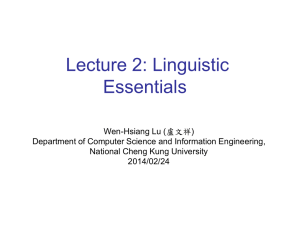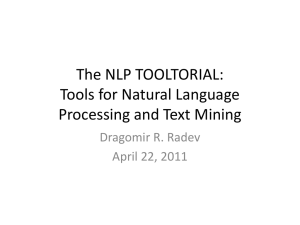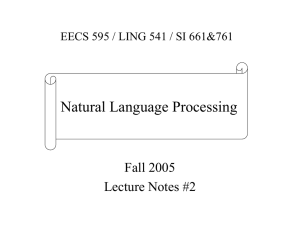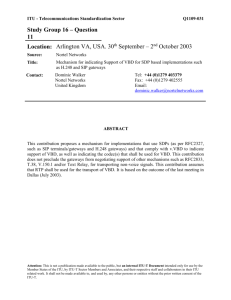statLecture11b
advertisement
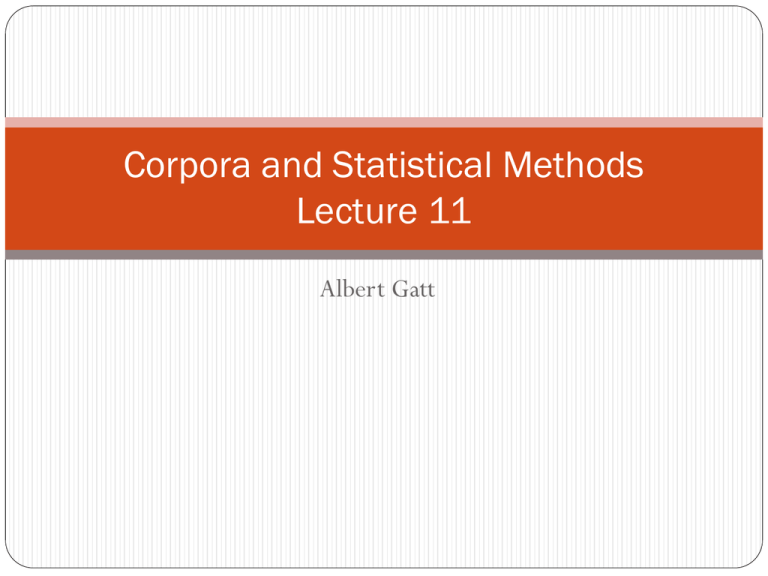
Corpora and Statistical Methods
Lecture 11
Albert Gatt
Part 2
Statistical parsing
Preliminary issues
How parsers are evaluated
Evaluation
The issue:
what objective criterion are we trying to maximise?
i.e. under what objective function can I say that my parser does “well”
(and how well?)
need a gold standard
Possibilities:
strict match of candidate parse against gold standard
match of components of candidate parse against gold standard
components
Evaluation
A classic evaluation metric is the PARSEVAL one
initiative to compare parsers on the same data
not initially concerned with stochastic parsers
evaluate parser output piece by piece
Main components:
compares gold standard tree to parser tree
typically, gold standard is the tree in a treebank
computes:
precision
recall
crossing brackets
PARSEVAL: labeled recall
# correct nodes in candidate parse
# nodes in treeban k parse
Correct node = node in candidate parse which:
has same node label
originally omitted from PARSEVAL to avoid theoretical conflict
spans the same words
PARSEVAL: labeled precision
# correct nodes in candidate parse
# nodes in candidate parse
The proportion of correctly labelled and correctly spanning
nodes in the candidate.
Combining Precision and Recall
As usual, Precision and recall can be combined into a
single F-measure:
F
1
1
1
(1 )
P
R
PARSEVAL: crossed brackets
number of brackets in the candidate parse which cross
brackets in the treebank parse
e.g. treebank has ((X Y) Z) and candidate has (X (Y Z))
Unlike precision/recall, this is an objective function to
minimise
Current performance
Current parsers achieve:
ca. 90% precision
>90% recall
1% cross-bracketed constituents
Some issues with PARSEVAL
1.
These measures evaluate parses at the level of individual
decisions (nodes).
2.
Success on crossing brackets depends on the kind of parse
trees used
3.
ignore the difficulty of getting a globally correct solution by
carrying out a correct sequence of decisions
Penn Treebank has very flat trees (not much embedding),
therefore likelihood of crossed brackets decreases.
In PARSEVAL, if a constituent is attached lower in a tree
than the gold standard, all its daughters are counted
wrong.
Probabilistic parsing with PCFGs
The basic algorithm
The basic PCFG parsing algorithm
Many statistical parsers use a version of the CYK algorithm.
Assumptions:
CFG productions are in Chomsky Normal Form.
A BC
Aa
Use indices between words:
Book the flight through Houston
(0) Book (1) the (2) flight (3) through (4) Houston (5)
Procedure (bottom-up):
Traverse input sentence left-to-right
Use a chart to store constituents and their span + their probability.
Probabilistic CYK: example PCFG
S NP VP [.80]
NP Det N [.30]
VP V NP [.20]
V includes [.05]
Det the [.4]
Det a [.4]
N meal [.01]
N flight [.02]
Probabilistic CYK: initialisation
The flight includes a meal.
//Lexical lookup:
for j = 1 to length(string) do:
chartj-1,j := {X : X->word in G}
//syntactic lookup
for i = j-2 to 0 do:
chartij := {}
for k = i+1 to j-1 do:
for each A -> BC do:
if B in chartik & C in chartkj:
chartij := chartij U {A}
1
0
1
2
3
4
5
2
3
4
5
Probabilistic CYK: lexical step
The flight includes a meal.
//Lexical lookup:
for j = 1 to length(string) do:
chartj-1,j := {X : X->word in G}
1
0
1
2
3
4
5
Det
(.4)
2
3
4
5
Probabilistic CYK: lexical step
The flight includes a meal.
//Lexical lookup:
for j = 1 to length(string) do:
chartj-1,j := {X : X->word in G}
1
0
1
2
3
4
5
2
Det
(.4)
N
.02
3
4
5
Probabilistic CYK: syntactic step
The flight includes a meal.
//Lexical lookup:
for j = 1 to length(string) do:
chartj-1,j := {X : X->word in G}
//syntactic lookup
for i = j-2 to 0 do:
chartij := {}
for k = i+1 to j-1 do:
for each A -> BC do:
if B in chartik & C in chartkj:
chartij := chartij U {A}
0
1
2
3
4
5
1
2
Det
(.4)
NP
.0024
N
.02
3
4
5
Probabilistic CYK: lexical step
The flight includes a meal.
//Lexical lookup:
for j = 1 to length(string) do:
chartj-1,j := {X : X->word in G}
0
1
2
3
4
5
1
2
Det
(.4)
NP
.0024
3
N
.02
V
.05
4
5
Probabilistic CYK: lexical step
The flight includes a meal.
//Lexical lookup:
for j = 1 to length(string) do:
chartj-1,j := {X : X->word in G}
0
1
2
3
4
5
1
2
Det
(.4)
NP
.0024
3
4
N
.02
V
.05
Det
.4
5
Probabilistic CYK: syntactic step
The flight includes a meal.
//Lexical lookup:
for j = 1 to length(string) do:
chartj-1,j := {X : X->word in G}
0
1
2
3
4
1
2
Det
(.4)
NP
.0024
3
4
5
N
.02
V
.05
Det
.4
N
.01
Probabilistic CYK: syntactic step
The flight includes a meal.
//Lexical lookup:
for j = 1 to length(string) do:
chartj-1,j := {X : X->word in G}
//syntactic lookup
for i = j-2 to 0 do:
chartij := {}
for k = i+1 to j-1 do:
for each A -> BC do:
if B in chartik & C in chartkj:
chartij := chartij U {A}
0
1
2
3
4
1
2
Det
(.4)
NP
.0024
3
4
5
Det
.4
NP
.001
N
.02
V
.05
N
.01
Probabilistic CYK: syntactic step
The flight includes a meal.
//Lexical lookup:
for j = 1 to length(string) do:
chartj-1,j := {X : X->word in G}
//syntactic lookup
for i = j-2 to 0 do:
chartij := {}
for k = i+1 to j-1 do:
for each A -> BC do:
if B in chartik & C in chartkj:
chartij := chartij U {A}
0
1
2
3
4
1
2
Det
(.4)
NP
.0024
3
4
5
N
.02
V
.05
VP
.00001
Det
.4
NP
.001
N
.01
Probabilistic CYK: syntactic step
The flight includes a meal.
//Lexical lookup:
for j = 1 to length(string) do:
chartj-1,j := {X : X->word in G}
//syntactic lookup
for i = j-2 to 0 do:
chartij := {}
for k = i+1 to j-1 do:
for each A -> BC do:
if B in chartik & C in chartkj:
chartij := chartij U {A}
0
1
2
3
4
1
2
Det
(.4)
NP
.0024
3
4
5
S
.00000001
92
N
.02
V
.05
VP
.00001
Det
.4
NP
.001
N
.01
Probabilistic CYK: summary
Cells in chart hold probabilities
Bottom-up procedure computes probability of a parse
incrementally.
To obtain parse trees, cells need to be augmented with
backpointers.
Probabilistic parsing with
lexicalised PCFGs
Main approaches (focus on Collins (1997,1999))
see also: Charniak (1997)
Unlexicalised PCFG Estimation
Charniak (1996) used Penn Treebank POS and phrasal
categories to induce a maximum likelihood PCFG
only used relative frequency of local trees as the estimates for rule
probabilities
did not apply smoothing or any other techniques
Works surprisingly well:
80.4% recall; 78.8% precision (crossed brackets not estimated)
Suggests that most parsing decisions are mundane and can be handled well by
unlexicalized PCFG
Probabilistic lexicalised PCFGs
Standard format of lexicalised rules:
associate head word with non-terminal
e.g. dumped sacks into
VP(dumped) VBD(dumped) NP(sacks) PP(into)
associate head tag with non-terminal
VP(dumped,VBD) VBD(dumped,VBD) NP(sacks,NNS) PP(into,IN)
Types of rules:
lexical rules expand pre-terminals to words:
e.g. NNS(sacks,NNS) sacks
probability is always 1
internal rules expand non-terminals
e.g. VP(dumped,VBD) VBD(dumped,VBD) NP(sacks,NNS)
PP(into,IN)
Estimating probabilities
Non-generative model:
take an MLE estimate of the probability of an entire rule
Count(VP(dumped, VBD ) VBD (dumped, VBD ) NP(sacks, NNS ) PP(into, IN))
Count(VP(dumped, VBD) )
non-generative models suffer from serious data sparseness problems
Generative model:
estimate the probability of a rule by breaking it up into sub-rules.
Collins Model 1
Main idea:
represent CFG rules as expansions into Head + left modifiers + right
modifiers
LHS STOP Ln Ln1...L1 H R1...Rn1Rn STOP
Li/Ri is of the form L/R(word,tag); e.g. NP(sacks,NNS)
STOP: special symbol indicating left/right boundary.
Parsing:
Given the LHS, generate the head of the rule, then the left modifiers (until
STOP) and right modifiers (until STOP) inside-out.
Each step has a probability.
Collins Model 1: example
VP(dumped,VBD) VBD(dumped,VBD) NP(sacks,NNS) PP(into,IN)
1.
Head H(hw,ht):
PH ( H (hw, ht ) | Parent , hw, ht )
P(VBD(dumped, VBD) | VP(dumped, VBD))
Collins Model 1: example
VP(dumped,VBD) VBD(dumped,VBD) NP(sacks,NNS) PP(into,IN)
1.
Head H(hw,ht):
PH ( H (hw, ht ) | Parent , hw, ht )
n 1
2.
Left modifiers:
P ( L (lw , lw ) | Parent , H , hw, ht )
L
i
i
t
i 1
P(STOP | VP(dumped, VBD) ,VBD(dumped, VBD))
Collins Model 1: example
VP(dumped,VBD) VBD(dumped,VBD) NP(sacks,NNS) PP(into,IN)
1.
Head H(hw,ht):
PH ( H (hw, ht ) | Parent , hw, ht )
n 1
2.
P ( L (lw , lw ) | Parent , H , hw, ht )
Left modifiers:
L
i
i
t
i 1
n 1
3.
Right modifiers:
P ( R (rw , rw ) | Parent , H , hw, ht )
R
i
i
t
i 1
PR ( NP(sacks, NNS ) | VP(dumped, VBD) ,VBD (dumped, VBD))
PR ( PP(into, IN ) | VP(dumped, VBD) ,VBD (dumped, VBD))
PR (STOP | VP(dumped, VBD) ,VBD (dumped, VBD))
Collins Model 1: example
VP(dumped,VBD) VBD(dumped,VBD) NP(sacks,NNS) PP(into,IN)
1.
Head H(hw,ht):
PH ( H (hw, ht ) | Parent , hw, ht )
n 1
2.
P ( L (lw , lw ) | Parent , H , hw, ht )
Left modifiers:
L
i
i
t
i 1
n 1
P ( R (rw , rw ) | Parent, H , hw, ht )
3.
Right modifiers:
4.
Total probability: multiplication of (1) – (3)
R
i
i
t
i 1
Variations on Model 1: distance
Collins proposed to extend rules by conditioning on
distance of modifiers from the head:
PL ( Li (lwi , lwt ) | P, H , hw, ht, distanceL (i 1))
PR ( Ri (rwi , rwt ) | P, H , hw, ht, distanceR (i 1))
a function of the yield of modifiers seen.
Distance for R2
probability =
words under R1
Using a distance function
Simplest kind of distance function is a tuple of binary features:
Is the string of length 0?
Does the string contain a verb?
…
Example uses:
if the string has length 0, PR should be higher:
English is right-branching & most right modifiers are adjacent to the head verb
if string contains a verb, PR should be higher:
accounts for preference to attach dependencies to main verb
Further additions
Collins Model 2:
subcategorisation preferences
distinction between complements and adjuncts.
Model 3 augmented to deal with long-distance (WH)
dependencies.
Smoothing and backoff
Rules may condition on
words that never occur in
training data.
Collins used 3-level
backoff model.
Combined using linear
interpolation.
1.
use head word
PR ( Ri (rwi , rwt ) | Parent , H , hw, ht )
2.
use head tag
PR ( Ri (rwi , rwt ) | Parent , H , ht )
3.
parent only
PR ( Ri (rwi , rwt ) | Parent )
Other parsing approaches
Data-oriented parsing
Alternative to “grammar-based” models
does not attempt to derive a grammar from a treebank
treebank data is stored as fragments of trees
parser uses whichever trees seem to be useful
Data-oriented parsing
Suppose we want to parse Sue heard Jim.
Corpus contains the following potentially useful fragments:
Parser can combine these to give
a parse
Data-oriented Parsing
Multiple fundamentally distinct derivations of a single tree.
Parse using Monte Carlo simulation methods:
randomly produce a large sample of derivations
use these to find the most probable parse
disadvantage: needs very large samples to make parses accurate,
therefore potentially slow
Data-oriented parsing vs. PCFGs
Possible advantages:
using partial trees directly accounts for lexical dependencies
also accounts for multi-word expressions and idioms (e.g. take
advantage of)
while PCFG rules only represent trees of depth 1, DOP fragments
can represent trees of arbitrary length
Similarities to PCFG:
tree fragments could be equivalent to PCFG rules
probabilities estimated for grammar rules are exactly the same as for
tree fragments
History Based Grammars (HBG)
General idea: any derivational step can be influenced by any
earlier derivational step
(Black et al. 1993)
the probability of expansion of the current node conditioned on
all previous nodes along the path from the root
History Based Grammars (HBG)
Black et al lexicalise their grammar.
every phrasal node inherits 2 words:
its lexical head H1
a secondary head H2, deemed to be useful
e.g. the PP in the bank might have H1=in and H2=bank
Every non-terminal is also assigned:
a syntactic category (Syn) e.g. PP
a semantic category (Sem) e.g with-Data
Use the index I that indicates what number child of the
parent node is being expanded
HBG Example (Black et al 1993)
History Based Grammars (HBG)
Estimation of the probability of a rule R:
P( Syn, Sem, R, H1 , H 2 | Syn p , Sem p , R p , I , H1p , H 2 p )
probability of:
the current rule R to be applied
its Syn and Sem category
its heads H1 and H2
conditioned on:
Syn and Sem of parent node
the rule that gave rise to the parent
the index of this child relative to the parent
the heads H1 and H2 of the parent
Summary
This concludes our overview of statistical parsing
We’ve looked at three important models
Also considered basic search techniques and algorithms
